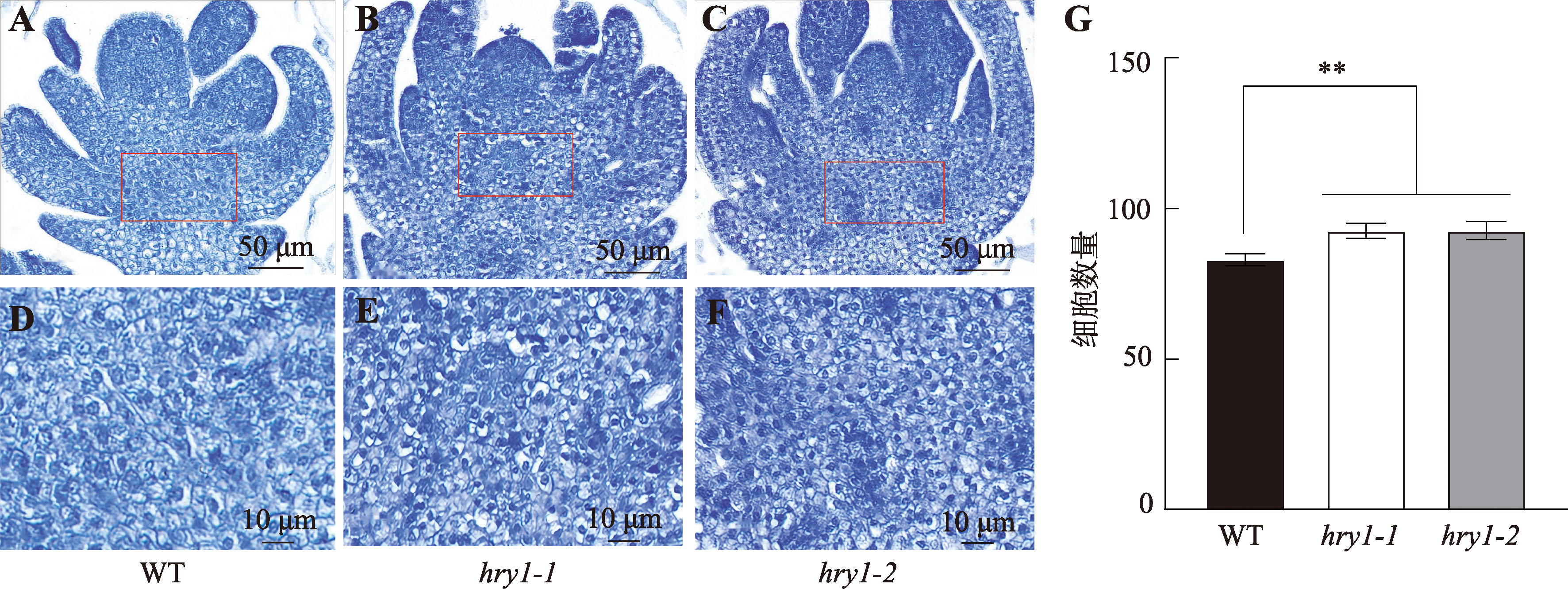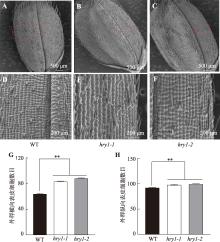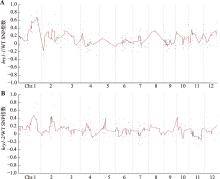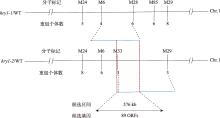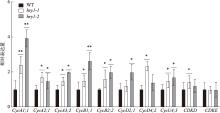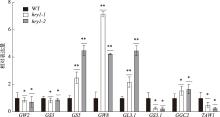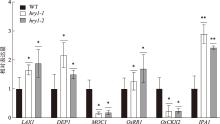Hereditas(Beijing) ›› 2025, Vol. 47 ›› Issue (7): 797-812.doi: 10.16288/j.yczz.25-084
• Research Article • Previous Articles Next Articles
Identification and gene mapping of hry1 mutant in rice
Jiadan Chen1( ), Tao Lin2, Wan Wang3, Cheng Jin4, Jianru Zuo3,5, Jinqiang Nian3(
), Tao Lin2, Wan Wang3, Cheng Jin4, Jianru Zuo3,5, Jinqiang Nian3( )
)
- 1. College of Tropical Agriculture and Forestry, Hainan University, Haikou 570228, China
2. College of Horticulture, China Agricultural University, Beijing 100193, China
3. Key Laboratory of Seed Innovation, Institute of Genetics and Developmental Biology, Chinese Academy of Sciences, Beijing 100101, China
4. School of Breeding and Multiplication (Sanya Institute of Breeding and Multiplication), Hainan University, Sanya 572025, China
5. Hainan Seed Laboratory, Sanya 572025, China
-
Received:2025-03-26Revised:2025-04-05Online:2025-07-20Published:2025-04-24 -
Contact:Jinqiang Nian E-mail:chenjiadan2022@163.com;jinqiang-nian@genetics.ac.cn -
Supported by:Outstanding Talent Team Project from Hainan Province
Cite this article
Jiadan Chen, Tao Lin, Wan Wang, Cheng Jin, Jianru Zuo, Jinqiang Nian. Identification and gene mapping of hry1 mutant in rice[J]. Hereditas(Beijing), 2025, 47(7): 797-812.
share this article
Add to citation manager EndNote|Reference Manager|ProCite|BibTeX|RefWorks
Table 1
Primers for map-based cloning of HRY1 used in this study"
| 引物名称 | 引物序列(5′→3′) |
|---|---|
| M6 | F:TAAACTGCATGCGACAAGAT R:TACAATAGCACGCAAAAGGA |
| M10 | F:CCCACTACTTGCTTTGATCT R:CCATAAGCTACTGTGAACGA |
| M24 | F:GACGAGGACTCCTATCTAGT R:AAATTGCTAGCACCAACTCT |
| M27 | F:GATGGCCATAAAGCGTAACT R:TAAAGGGCAGGTATCGAATG |
| M28 | F:AGAAACAGTACGGTTGGTTT R:TGGCAACAGATCGTCATAAT |
| M29 | F:TTCTGCATAGACATCCCCTA R:TAAAAATCTCGAGGGTGAGC |
| M33 | F:ATCAATCCGCGATTACCTTT R:GTATTCGTGGGCTATTCACT |
| M39 | F:GTTCCGCATGCAAGACAT R:GGCTTACGGTCCAATAAGAA |
| M85 | F:GGGCAGAGAATTACTTTAAC R:TGAAGGAGATGAATCGAAGC |
Table 2
Primers for qRT-PCR used in this study"
| 基因名称 | 引物序列(5'→3') | 基因名称 | 引物序列(5'→3') |
|---|---|---|---|
| GW2 | F:CAgCAgCgCATTCCCAgTTTTC | IPA1 | F:GGATATGGTGCCAACACATACAG |
| R:GTGGTCAGCCGAGCACTCTC | R:GACATGGCTGCAGCCTGGTTGTG | ||
| GS3 | F:CATCGGAGAAGCGAAGTCAT | CycA1;1 | F:GTTTCGGTTGACGAGACGATGT |
| R:TTGAGGTTGAAGGAGGAGGA | R:CGCTGCAAGGAACCTAGAACTG | ||
| GS5 | F:CATTCCATGCAAATGCCAGTGGAC | CycA2;1 | F:AATATTGAGCGAAACAGGGACAG |
| R:CAGCCCTGCTTTGATGAGCTTG | R:AGGAAGCACACATTTGAGGATTT | ||
| GW8 | F:AGGAGTTTGATGAGGCCAAG | CycA3;2 | F:AGGTTGTCAAGATGGAGAGCGA |
| R:GCGTGTAGTATGGGCTCTCC | R:CGCTTTTTGTCTTCCTGGCA | ||
| GL3.1 | F:TCACAACTCCCAGGATAGG | CycB1;1 | F:CACTCTCAAGCACCACACTGGA |
| R:TTTGTCTCGCTCGCTCAT | R:ACAACCCTCAGCTTGCTCTCAG | ||
| GS3.1 | F:ATCTCGATGCTGTTCCTTGGC | CycB2;2 | F:CTCAAGGCTGCACAATCTGACA |
| R:AGATGGGCTCCATCCCGAG | R:GCATTGACGGCTGGAATTTG | ||
| GGC2 | F:GTGCAACTGCTTGTTATGCC | CycD2;1 | F:GATTGGAGTGTTCTTGGAGGAAA |
| R:GCTCGGTCTACAGCACGAT | R:TGTTGCATCCAAGATTCGTCAT | ||
| TAW1 | F:FGCTGGAGAAGACGAAGAAAGATAG | CycD4;2 | F:TGGTAGAAGAAGACATCGCAGAG |
| R:CATTCCCCCTCCTCCTCC | R:TCTCCTGGTGCTTGCAGGTT | ||
| LAX1 | F:CAAGAGGCGGTGGGCTAC | CycU4;3 | F:GCCTCCTCATCACATCCGTC |
| R:ACCGTGGACATTGCACACC | R:GCCAAAGAGGAAGTCCACCTC | ||
| DEP1 | F:GTGTGGAGATGGGGGAGGAG | CDKD | F:GGTCCTGGGAGAGGGAACC |
| R:AGCTCATCCTTGAGGAACGTGA | R:TTAATTTCCCTCAATGCAGTGAA | ||
| MOC1 | F:GCTCGCCCTCCCTATTAAAC | CDKE | F:TACGCCGAGCACGATCTCTA |
| R:CACCACCAGAGCTACTACAAC | R:GGAGATAGTTGAGACCATTGAGCA | ||
| OsRR1 | F:CTTCGCTGGAGTTGCCAT | UBQ | F:ACCCTGGCTGACTACAACATC |
| R:TCAAGCACACCACAGGTT | R:AGTTGACAGCCCTAGGGTG | ||
| OsCKX2 | F:TGTCCCTTCTACAATGGTGC | ||
| R:CATCCTGACCTGCTCTTGCT |
| [1] | Yan YP, Yu XQ, Ren DY, Qian Q. Genetic mechanisms and breeding utilization of grain number per panicle in rice. Chin Bull Bot, 2023, 58(3): 359-372. |
| 严语萍, 俞晓琦, 任德勇, 钱前. 水稻穗粒数遗传机制与育种利用. 植物学报, 2023, 58(3): 359-372. | |
| [2] |
Ying JZ, Ma M, Bai C, Huang XH, Liu JL, Fan YY, Song XJ. TGW3, a major QTL that negatively modulates grain length and weight in rice. Mol Plant, 2018, 11(5): 750-753.
pmid: 29567450 |
| [3] |
Ashikari M, Sakakibara H, Lin SY, Yamamoto T, Takashi T, Nishimura A, Angeles ER, Qian Q, Kitano H, Matsuoka M. Cytokinin oxidase regulates rice grain production. Science, 2005, 309(5735): 741-745.
pmid: 15976269 |
| [4] |
Huang XZ, Qian Q, Liu ZB, Sun HY, He SY, Luo D, Xia GM, Chu CC, Li JY, Fu XD. Natural variation at the DEP1 locus enhances grain yield in rice. Nat Genet, 2009, 41(4): 494-497.
pmid: 19305410 |
| [5] | Taguchi-Shiobara F, Kawagoe Y, Kato H, Onodera H, Tagiri A, Hara N, Miyao A, Hirochika H, Kitano H, Yano M, Toki S. A loss-of-function mutation of rice DENSE PANICLE 1 causes semi-dwarfness and slightly increased number of spikelets. Breed Sci, 2011, 61(1): 17-25. |
| [6] |
Zhou Y, Zhu JY, Li ZY, Yi CD, Liu J, Zhang HG, Tang SZ, Gu MH, Liang GH. Deletion in a quantitative trait gene qPE9-1 associated with panicle erectness improves plant architecture during rice domestication. Genetics, 2009, 183(1): 315-324.
pmid: 19546322 |
| [7] |
Jiao YQ, Wang YH, Xue DW, Wang J, Yan MX, Liu GF, Dong GJ, Zeng DL, Lu ZF, Zhu XD, Qian Q, Li JY. Regulation of OsSPL14 by OsmiR156 defines ideal plant architecture in rice. Nat Genet, 2010, 42(6): 541-544.
pmid: 20495565 |
| [8] |
Miura K, Ikeda M, Matsubara A, Song XJ, Ito M, Asano K, Matsuoka M, Kitano H, Ashikari M. OsSPL14 promotes panicle branching and higher grain productivity in rice. Nat Genet, 2010, 42(6): 545-549.
pmid: 20495564 |
| [9] |
Lu ZF, Yu H, Xiong GS, Wang J, Jiao YQ, Liu GF, Jing YH, Meng XB, Hu XM, Qian Q, Fu XD, Wang YH, Li JY. Genome-wide binding analysis of the transcription activator ideal plant architecture1 reveals a complex network regulating rice plant architecture. Plant Cell, 2013, 25(10): 3743-3759.
pmid: 24076974 |
| [10] |
Luo JH, Liu H, Zhou TY, Gu BG, Huang XH, Shangguan YY, Zhu JJ, Li Y, Zhao Y, Wang YC, Zhao Q, Wang AH, Wang ZQ, Sang T, Wang ZX, Han B. An-1 encodes a basic helix-loop-helix protein that regulates awn development, grain size, and grain number in rice. Plant Cell, 2013, 25(9): 3360-3376.
pmid: 35449414 |
| [11] |
Song XG, Meng XB, Guo HY, Cheng Q, Jing YH, Chen MJ, Liu GF, Wang B, Wang YH, Li JY, Yu H. Targeting a gene regulatory element enhances rice grain yield by decoupling panicle number and size. Nat Biotechnol, 2022, 40(9): 1403-1411.
pmid: 20566706 |
| [12] |
Wei XJ, Xu JF, Guo HN, Jiang L, Chen SH, Yu CY, Zhou ZL, Hu PS, Zhai HQ, Wan JM. DTH8 suppresses flowering in rice, influencing plant height and yield potential simultaneously. Plant Physiol, 2010, 153(4): 1747-1758.
pmid: 20566706 |
| [13] |
Xue WY, Xing YZ, Weng XY, Zhao Y, Tang WJ, Wang L, Zhou HJ, Yu SB, Xu CG, Li XH, Zhang QF. Natural variation in Ghd7 is an important regulator of heading date and yield potential in rice. Nat Genet, 2008, 40(6): 761-767.
pmid: 18454147 |
| [14] |
Yan WH, Wang P, Chen HX, Zhou HJ, Li QP, Wang CR, Ding ZH, Zhang YS, Yu SB, Xing YZ, Zhang QF. A major QTL, Ghd8, plays pleiotropic roles in regulating grain productivity, plant height, and heading date in rice. Mol Plant, 2011, 4(2): 319-330.
pmid: 21148627 |
| [15] |
Ikeda-Kawakatsu K, Maekawa M, Izawa T, Itoh JI, Nagato Y. ABERRANT PANICLE ORGANIZATION 2/RFL, the rice ortholog of Arabidopsis LEAFY, suppresses the transition from inflorescence meristem to floral meristem through interaction with APO1. Plant J, 2012, 69(1): 168-180.
pmid: 21910771 |
| [16] |
Kobayashi K, Maekawa M, Miyao A, Hirochika H, Kyozuka J. PANICLE PHYTOMER2 (PAP2), encoding a SEPALLATA subfamily MADS-box protein, positively controls spikelet meristem identity in rice. Plant Cell Physiol, 2010, 51(1): 47-57.
pmid: 19933267 |
| [17] |
Komatsu M, Maekawa M, Shimamoto K, Kyozuka J. The LAX1 and FRIZZY PANICLE 2 genes determine the inflorescence architecture of rice by controlling rachis-branch and spikelet development. Dev Biol, 2001, 231(2): 364-373.
pmid: 11237465 |
| [18] |
Komatsu M, Chujo A, Nagato Y, Shimamoto K, Kyozuka J. FRIZZY PANICLE is required to prevent the formation of axillary meristems and to establish floral meristem identity in rice spikelets. Development, 2003, 130(16): 3841-3850.
pmid: 12835399 |
| [19] |
Tabuchi H, Zhang Y, Hattori S, Omae M, Shimizu-Sato S, Oikawa T, Qian Q, Nishimura M, Kitano H, Xie H, Fang XH, Yoshida H, Kyozuka J, Chen F, Sato Y. LAX PANICLE2 of rice encodes a novel nuclear protein and regulates the formation of axillary meristems. Plant Cell, 2011, 23(9): 3276-3287.
pmid: 21963665 |
| [20] |
Dong Q, Zhang ZH, Wang LL, Zhu YJ, Fan YY, Mou TM, Ma LY, Zhuang JY. Dissection and fine-mapping of two QTL for grain size linked in a 460-kb region on chromosome 1 of rice. Rice (N Y), 2018, 11(1): 44.
pmid: 30073424 |
| [21] |
Zhang T, Wang SM, Sun SF, Zhang Y, Li J, You J, Su T, Chen WB, Ling YH, He GH, Zhao FM. Analysis of QTL for grain size in a rice chromosome segment substitution line Z1392 with long grains and fine mapping of qGL-6. Rice (N Y), 2020, 13(1): 40.
pmid: 32529315 |
| [22] |
Yu JP, Miao JL, Zhang ZY, Xiong HY, Zhu XY, Sun XM, Pan YH, Liang YT, Zhang Q, Abdul Rehman RM, Li JJ, Zhang HL, Li ZC. Alternative splicing of OsLG3b controls grain length and yield in japonica rice. Plant Biotechnol J, 2018, 16(9): 1667-1678.
pmid: 29479793 |
| [23] | Tian FK. Genetic studies and QTL mapping of yield- related traits in rice[Dissertation]. Hangzhou Normal University, 2013. |
| 田福宽. 水稻产量相关性状的遗传研究和QTL定位[学位论文]. 杭州师范大学, 2013. | |
| [24] |
Fan CC, Xing YZ, Mao HL, Lu TT, Han B, Xu CG, Li XH, Zhang QF. GS3, a major QTL for grain length and weight and minor QTL for grain width and thickness in rice, encodes a putative transmembrane protein. Theor Appl Genet, 2006, 112(6): 1164-1171.
pmid: 16453132 |
| [25] |
Sun HY, Qian Q, Wu K, Luo JJ, Wang SS, Zhang CW, Ma YF, Liu Q, Huang XZ, Yuan QB, Han RX, Zhao M, Dong GJ, Guo LB, Zhu XD, Gou ZH, Wang W, Wu YJ, Lin HX, Fu XD. Heterotrimeric G proteins regulate nitrogen-use efficiency in rice. Nat Genet, 2014, 46(6): 652-656.
pmid: 24777451 |
| [26] |
Zhang XJ, Wang JF, Huang J, Lan HX, Wang CL, Yin CF, Wu YY, Tang HJ, Qian Q, Li JY, Zhang HS. Rare allele of OsPPKL1 associated with grain length causes extra-large grain and a significant yield increase in rice. Proc Natl Acad Sci USA, 2012, 109(52): 21534-21539.
pmid: 23236132 |
| [27] |
Choi BS, Kim YJ, Markkandan K, Koo YJ, Song JT, Seo HS. GW2 functions as an E3 ubiquitin ligase for rice Expansin-Like 1. Int J Mol Sci, 2018, 19(7): 1904.
pmid: 29958473 |
| [28] |
Song XJ, Huang W, Shi M, Zhu MZ, Lin HX. A QTL for rice grain width and weight encodes a previously unknown RING-type E3 ubiquitin ligase. Nat Genet, 2007, 39(5): 623-630.
pmid: 17417637 |
| [29] |
Duan PG, Xu JS, Zeng DL, Zhang BL, Geng MF, Zhang GZ, Huang K, Huang LJ, Xu R, Ge S, Qian Q, Li YH. Natural variation in the promoter of GSE5 contributes to grain size diversity in rice. Mol Plant, 2017, 10(5): 685-694.
pmid: 28366824 |
| [30] |
Liu JF, Chen J, Zheng XM, Wu FQ, Lin QB, Heng YQ, Tian P, Cheng ZJ, Yu XW, Zhou KN, Zhang X, Guo XP, Wang JL, Wang HY, Wan JM. GW5 acts in the brassinosteroid signalling pathway to regulate grain width and weight in rice. Nat Plants, 2017, 3: 17043.
pmid: 28394310 |
| [31] |
Li YB, Fan CC, Xing YZ, Jiang YH, Luo LJ, Sun L, Shao D, Xu CJ, Li XH, Xiao JH, He YQ, Zhang QF. Natural variation in GS5 plays an important role in regulating grain size and yield in rice. Nat Genet, 2011, 43(12): 1266-1269.
pmid: 22019783 |
| [32] |
Che RH, Tong HN, Shi BH, Liu YQ, Fang SR, Liu DP, Xiao YH, Hu B, Liu LC, Wang HR, Zhao MF, Chu CC. Control of grain size and rice yield by GL2-mediated brassinosteroid responses. Nat Plants, 2015, 2: 15195.
pmid: 27250747 |
| [33] |
Duan PG, Ni S, Wang JM, Zhang BL, Xu R, Wang YX, Chen HQ, Zhu XD, Li YH. Regulation of OsGRF4 by OsmiR396 controls grain size and yield in rice. Nat Plants, 2015, 2: 15203.
pmid: 27250749 |
| [34] |
Hu J, Wang YX, Fang YX, Zeng LJ, Xu J, Yu HP, Shi ZY, Pan JJ, Zhang D, Kang SJ, Zhu L, Dong GJ, Guo LB, Zeng DL, Zhang GH, Xie LH, Xiong GS, Li JY, Qian Q. A rare allele of GS2 enhances grain size and grain yield in rice. Mol Plant, 2015, 8(10): 1455-1465.
pmid: 26187814 |
| [35] |
Si LZ, Chen JY, Huang XH, Gong H, Luo JH, Hou QQ, Zhou TY, Lu TT, Zhu JJ, Shangguan YY, Chen EW, Gong CX, Zhao Q, Jing YF, Zhao Y, Li Y, Cui LL, Fan DL, Lu YQ, Weng QJ, Wang YC, Zhan QL, Liu KY, Wei XH, An K, An G, Han B. OsSPL13 controls grain size in cultivated rice. Nat Genet, 2016, 48(4): 447-456.
pmid: 26950093 |
| [36] |
Wang SK, Li S, Liu Q, Wu K, Zhang JQ, Wang SS, Wang Y, Chen XB, Zhang Y, Gao CX, Wang F, Huang HX, Fu XD. The OsSPL16-GW7 regulatory module determines grain shape and simultaneously improves rice yield and grain quality. Nat Genet, 2015, 47(8): 949-954.
pmid: 26147620 |
| [37] |
Wang SK, Wu K, Yuan QB, Liu XY, Liu ZB, Lin XY, Zeng RZ, Zhu HT, Dong GJ, Qian Q, Zhang GQ, Fu XD. Control of grain size, shape and quality by OsSPL16 in rice. Nat Genet, 2012, 44(8): 950-954.
pmid: 22729225 |
| [38] |
Wang YX, Xiong GS, Hu J, Jiang L, Yu H, Xu J, Fang YX, Zeng LJ, Xu EB, Xu J, Ye WJ, Meng XB, Liu RF, Chen HQ, Jing YH, Wang YH, Zhu XD, Li JY, Qian Q. Copy number variation at the GL7 locus contributes to grain size diversity in rice. Nat Genet, 2015, 47(8): 944-948.
pmid: 26147619 |
| [39] |
Allen GC, Flores-Vergara MA, Krasynanski S, Kumar S, Thompson WF. A modified protocol for rapid DNA isolation from plant tissues using cetyltrimethylammonium bromide. Nat Protoc, 2006, 1(5): 2320-2325.
pmid: 17406474 |
| [40] |
Abe A, Kosugi S, Yoshida K, Natsume S, Takagi H, Kanzaki H, Matsumura H, Yoshida K, Mitsuoka C, Tamiru M, Innan H, Cano L, Kamoun S, Terauchi R. Genome sequencing reveals agronomically important loci in rice using MutMap. Nat Biotechnol, 2012, 30(2): 174-178.
pmid: 22267009 |
| [41] |
Qi P, Lin YS, Song XJ, Shen JB, Huang W, Shan JX, Zhu MZ, Jiang LW, Gao JP, Lin HX. The novel quantitative trait locus GL3.1 controls rice grain size and yield by regulating Cyclin-T1;3. Cell Res, 2012, 22(12): 1666-1680.
pmid: 23147796 |
| [1] | Nian Guo, Chenjie Wang, Zhao Li, Nannan Han, Chen Zhou, Kaiying Wang, Ke Huang, Yongqing Pan, Yingjie Li, Yunhai Li. Genetic analysis and identification of candidate genes for a narrow and long grain mutant (nlg1) in rice [J]. Hereditas(Beijing), 2025, 47(6): 672-680. |
| [2] | Zhanchun Wang, Guitao Zhong, Beibei Zhang, Yilin Xie, Dingzhong Tang, Wei Wang. Research advances in rice blast resistance genes [J]. Hereditas(Beijing), 2025, 47(5): 533-545. |
| [3] | Jiawen Ma, Xinle Liang. Analysis of structure and function of phage community occurring in the abnormal fermentation of vinegar mash through virome sequencing [J]. Hereditas(Beijing), 2025, 47(4): 489-498. |
| [4] | Yueyang Wu, Xiaoyan Zhou, Yufeng Wu, Ju Huang. Effects of functional defects in the NMD pathway on rice phenotype and transcriptome [J]. Hereditas(Beijing), 2024, 46(7): 540-551. |
| [5] | Zhong Bian, Dongping Cao, Wenshu Zhuang, Shuwei Zhang, Qiaoquan Liu, Lin Zhang. Revelation of rice molecular design breeding: the blend of tradition and modernity [J]. Hereditas(Beijing), 2023, 45(9): 718-740. |
| [6] | Xiangdong Liu, Jinwen Wu, Zijun Lu, Muhammad Qasim Shahid. Autotetraploid rice: challenges and opportunities [J]. Hereditas(Beijing), 2023, 45(9): 781-792. |
| [7] | Zhenwu Zheng, Hongyuan Zhao, Xiaoya Liang, Yijun Wang, Chihang Wang, Gaoyan Gong, Jinyan Huang, Guiquan Zhang, Shaokui Wang, Zupei Liu. qGL3.4 controls kernel size and plant architecture in rice [J]. Hereditas(Beijing), 2023, 45(9): 835-844. |
| [8] | Mingjiang Chen, Guifu Liu, Yeqing Xiao, Hong Yu, Jiayang Li. Breeding of ZhongKeFaZaoGeng1 by molecular design [J]. Hereditas(Beijing), 2023, 45(9): 829-834. |
| [9] | Xiaoping Lian, Guangfu Huang, Yujiao Zhang, Jing Zhang, Fengyi Hu, Shilai Zhang. The discovery and utilization of favorable genes in Oryza longistaminata [J]. Hereditas(Beijing), 2023, 45(9): 765-780. |
| [10] | Yongqiang Liu, Weiwei Li, Xinyu Liu, Chengcai Chu. Molecular mechanism of tillering response to nitrogen in rice [J]. Hereditas(Beijing), 2023, 45(5): 367-378. |
| [11] | Cuiling Wang, Xinyi Liu, Yahui Wang, Zheng Zhang, Zhidong Wang, Gangqiao Zhou. MCM2 promotes the proliferation, migration and invasion of cholangiocarcinoma cells by reducing the p53 signaling pathway [J]. Hereditas(Beijing), 2022, 44(3): 230-244. |
| [12] | Shan Li, Yunzhi Huang, Xueying Liu, Xiangdong Fu. Genetic improvement of nitrogen use efficiency in crops [J]. Hereditas(Beijing), 2021, 43(7): 629-641. |
| [13] | Changquan Zhang, Linhao Feng, Minghong Gu, Qiaoquan Liu. Progress on inheritance and gene cloning for rice grain quality in Jiangsu province [J]. Hereditas(Beijing), 2021, 43(5): 425-441. |
| [14] | Cailin Wang, Yadong Zhang, Chunfang Zhao, Xiaodong Wei, Shu Yao, Lihui Zhou, Zhen Zhu, Tao Chen, Qingyong Zhao, Ling Zhao, Kai Lu, Wenhua Liang. Inheritance and breeding of japonica rice with good eating quality in Jiangsu province [J]. Hereditas(Beijing), 2021, 43(5): 442-458. |
| [15] | Hang Dai, Yan Li, Shunchun Liu, Lei Lin, Juanyan Wu, Zhijie Zhang, Qichun Peng, Nan Li, Xiangqian Zhang. Effect of extensin-like OsPEX1 on pollen fertility in rice [J]. Hereditas(Beijing), 2021, 43(3): 271-279. |
| Viewed | ||||||
|
Full text |
|
|||||
|
Abstract |
|
|||||









